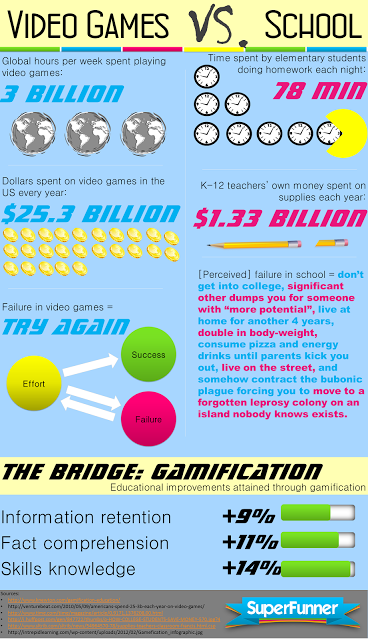5 Reasons to “Gamify” Your Class

Imagine if students were as motivated to do their schoolwork as they are to beat Halo 4. “Gamification” is a fancy word to describe how to achieve exactly that - bringing game-like engagement to non-game settings - and it’s beginning to pervade all aspects of life, including education.
For example, Sam Webster, a 4th grade teacher, gamified her class using a teacher-created project called SuperFunner. “I’ve seen kids who aren’t normally excited become really excited about school all of a sudden,” Webster said about the system.
Here are 5 reasons to consider gamifying your class.
- Engagement - If you’ve ever played or watched someone play a good video game, you’ll know that nothing engages people like games do. Even kids who are normally unfocused, unmotivated, or undisciplined become highly focused, motivated, and disciplined when playing games. Gamification can help bring those attitudes to class.
- Intrinsic motivation - Not only do kids spend significant amounts of time playing games, but they do so voluntarily, with no hope of earning extrinsic rewards like candy or pizza parties. Gamification is all about guiding people to achieve things that perfectly challenging them, and typically the only incentive to do so is the sense of accomplishment they feel when they succeed.
- Extension of learning - It’s tough to design a course that challenges each student to the level they need. Video games, however, somehow manage to capture the full attention of multitudes of people at a myriad of skill levels simultaneously. Gamification can help deliver challenges at the right level for all students in a class, whether they’re two grades behind in reading comprehension or three grades ahead in math.
- You’re already doing it - School is inherently game-like - students earn points for completing challenges, and are eventually rewarded with badges in the form of grades. Gamification only improves the current system by employing game elements proven to be extraordinarily effective in video games. If we’re already doing it, we might as well do it right!
- Straight up fun - It’s just more fun!
This infographic helps put the significance of video games in relation to school in perspective.

For more information about gamifying school visit http://www.SuperFunner.com
Lisa Nielsen writes for and speaks to audiences across the globe about learning innovatively and is frequently covered by local and national media for her views on “Passion (not data) Driven Learning,” "Thinking Outside the Ban" to harness the power of technology for learning, and using the power of social media to provide a voice to educators and students. Ms. Nielsen has worked for more than a decade in various capacities to support learning in real and innovative ways that will prepare students for success. In addition to her award-winning blog, The Innovative Educator, Ms. Nielsen’s writing is featured in places such as Huffington Post, Tech & Learning, ISTE Connects, ASCD Wholechild, MindShift, Leading & Learning, The Unplugged Mom, and is the author the book Teaching Generation Text.
Disclaimer: The information shared here is strictly that of the author and does not reflect the opinions or endorsement of her employer.
Tools and ideas to transform education. Sign up below.
Lisa Nielsen (@InnovativeEdu) has worked as a public-school educator and administrator since 1997. She is a prolific writer best known for her award-winning blog, The Innovative Educator. Nielsen is the author of several books and her writing has been featured in media outlets such as The New York Times, The Wall Street Journal, and Tech & Learning.
Disclaimer: The information shared here is strictly that of the author and does not reflect the opinions or endorsement of her employer.
